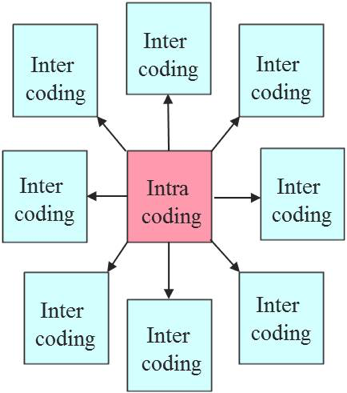群体图像编码
利用图像间的相关性,对一组(群)图像进行联合编码,达到去除图像间冗余的目的,提高群体图像的压缩存储效率。传统的图像编码方法,如JPEG、JPEG2000等,只是针对单幅图像内部的冗余特性,通过预测、变换等编码方法对一幅图像进行压缩。而在当今大数据时代海量存储的图像数据间还存在着很大的冗余,有着进一步压缩的空间。比如人们会习惯于在同一地点、对于同一物体拍摄多张照片,这些照片可能有光照、人物表情姿势、拍摄角度等的差异,但景物内容的相同使得图片之间存在非常大相似性。不仅是同一相册的照片具有冗余性,不同人在同一地点拍摄的照片同样具有相关性,这些图像间存在大量信息冗余。因此,可以对图像之间的信息相关性加以利用,来进一步提升压缩效率。
对群体图像进行高效编码的关键是如何有效地组织这些相似图像,在图像间进行高效的预测编码。经典的组织结构有中心型预测[3]和最小生成树预测[9]。如图1所示,中心型预测即选择一副图像为预测中心,其他所有图像都参考这幅图像进行预测,比较适合图像间冗余度较高的群体图像,同时便于群体图像的插入、删除管理;如图2所示,最小生成树预测首先根据图像间冗余度建立一个最小生成树,然后按照深度优先的访问顺序,采用视频帧间预测的压缩方式进行编码。和中心型预测相比,最小生成树预测可以有更多参考图像进行预测,但这种灵活的预测结构也给群体图像的管理带来不便。
参考文献
[1] Z. Shi, X. Sun and F. Wu. Feature based Image Set Compression. Proceedings of the IEEE International Conference on Multimedia and Expo (ICME), San Jose, CA, pp. 1-6, 2013.
[2] Z. Shi, X. Sun, and F. Wu. Multi-model prediction for image set compression. Proceedings of the IEEE International Conference on Visual Communications and Image Processing (VCIP). Kuching, Malaysia, 2013: pp. 1-6.
[3] K. Karadimitriou and J. M. Tyler. The centroid method for compressing sets of similar images. Pattern Recognition Letters, 1998, 19(7): 585 – 593.
[4] Y. S. Musatenko and V. N. Kurashov. Correlated image set compression system based on new fast efficient algorithm of karhunen-loeve transform. Photonics East, 1988, 3527(10): pp.518–529.
[5] S. Ait-Aoudia and A. Gabis. A comparison of set redundancy compression techniques. EURASIP Journal on Applied Signal Processing, 2006, 2006(15): 1–13.
[6] H. Cheng, X. Li, A. Schmieder, A study of clustering algorithms and validity for lossy image set compression. Proceedings of the International Conference on Image Processing, Computer Vision and Pattern Recognition (IPCV). Las Vegas, Nevada, USA, 2009: 501 –506.
[7] A. George, E. Yasser, H. Meer. Quadtree-Based Centroid Technique for Compressing Sets of Similar Medical Images. Proceedings of the 4th International Conference on Intelligent Systems Design and Applications. Budapest, Hungary, 2004: 1-6.
[8] C. Yeung, Oscar C. Au, K. Tang, Z. Yu, E. Luo, Y. Wu, and S. F. Tu. Compressing similar image sets using low frequency template. Proceedings of the IEEE International Conference on Multimedia and Expo (ICME). Barcelona, Spain, 2011: 1 –6.
[9] C. Nielsen and X. Li. MST for lossy compression of image sets. Proceedings of the Data Compression Conference. Snowbird, Utah, US, 2006: 463 –463.
[10] B. Gergel, H. Cheng, C. Nielsen, and X. Li. A unified framework for image set compression. Proceedings of the International Conference on Image Processing, Computer Vision, & Pattern Recognition (IPCV), Las Vegas, Nevada, USA, 2006: 417–423.
[11] B. Gergel, A. Schmieder, X. Li, and H. Cheng. A study of prediction measures for lossy image set compression. Proceedings of the International Conference on Image Processing, Computer Vision, and Pattern Recognition (IPCV). Las Vegas, Nevada, USA, 2008: 69–74.
[12] J. Ranger and H. Cheng. Structural similarity as a prediction metric in lossy image set compression. Proceedings of the International Conference on Image Processing, Computer Vision, and Pattern Recognition (IPCV). Las Vegas, Nevada, USA, 2012:1-6.
[13] H. Yue, X. Sun, J. Yang, and F. Wu. Cloud-Based Image Coding for Mobile Devices—Toward Thousands to One Compression. IEEE Transactions on Multimedia, 2013, 15(4): 845-857.

